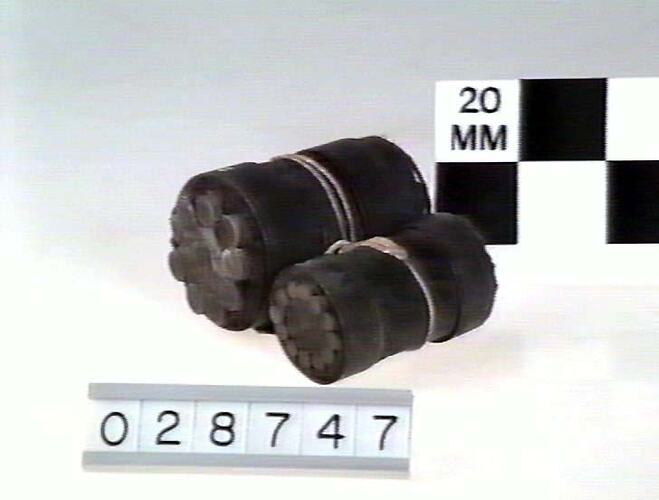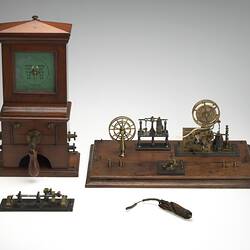These two samples of cable were donated by Mrs H. F. Chaffey of Mildura. The two pieces are said to be from the first trans-Atlantic telegraph cable laid in 1857. The Chaffey family of Mildura originated from Canada. Cyrus Field, the man behind the trans-Atlantic submarine telegraph project, was a friend of Benjamin Chaffey and gave him the two cable samples. Benjamin Chaffey was an uncle of George and William Benjamin Chaffey, the two brothers who founded the town of Mildura in north-eastern Victoria. When Benjamin Chaffey died the cable samples were passed through various family members to Mrs H. F. Chaffey.
Neither of the samples match the published descriptions of the 1857-58 cable laid between Ireland and Newfoundland. However, the sample with smaller diameter (deep-sea section) does match published descriptions of the cable laid across Cabot Strait betweeen Newfoundland and Nova Scotia in 1856. The section with larger diameter is probably a sample of the shore-end of the same link.
The Cabot Strait link was the first stage in the project to connect North America with Europe by telegraph.
The smaller sample
The smaller of the two cable sections has a central conductor strand of 7 wires, surrounded by insulation to a diameter of about 13 mm, and armoured with 12 solid wires, each of about 3.8mm diameter (No. 9 BWG). This closely matches the description of the 1856 Cabot Strait cable from Nova Scotia to Newfoundland, available at http://www.atlantic-cable.com/Cables/1856CabotStraitCable/index.htm. So it seems probable that this object is a sample of the deep-sea section of the 1856 Cabot Strait cable.
The larger sample
The larger of the two cable sections has a central conductor strand of 7 wires, surrounded by insulation to about 15 mm diameter, and armoured with 9 solid wires, each of about 7.2 mm diameter (No. 2 BWG). It is possible that this cable sample could be from the shore-end section of the Cabot Strait cable but no description of the latter has been located.
The 1857 cable
According to Russell's The Atlantic Telegraph, the 1857 trans-Atlantic cable consisted of a central copper conductor which was a strand made up of 7 wires. The conductor was covered in three layers of gutta percha. The core thus formed was armoured by wrapping it in eighteen strands of iron wire, each strand comprising seven individual wires. This description presumably applies to the deep-sea cable. Russell gives no details of the shore end armouring but some images show this consisted of 12 solid wires wrapped around the core and separated from it by additional insulating material.
References:
The Atlantic Telegraph, by W. H. Russell, first published in 1866, republished in 2005 by Nonsuch Publishing Ltd.
http://www.atlantic-cable.com/Cables/1856CabotStraitCable/index.htm.
More Information
-
Keywords
-
Authors
-
Article types



